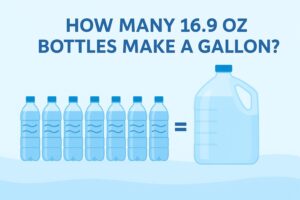
Building muscle is one of the most rewarding aspects of fitness, but it can be disheartening when progress feels slow. Many people wonder, How much muscle can I realistically gain in a year?
Whether you’re just starting your fitness journey or you’ve been lifting for a while and are looking to break through plateaus, knowing what to expect helps you set achievable goals and stay motivated.
In this post, I’ll guide you through how much muscle you can expect to gain in a year, depending on your current fitness level, the factors influencing muscle growth, and practical tips to help you reach your potential.
Understanding Muscle Growth Basics

Muscle growth, or hypertrophy, occurs when your muscles respond to resistance training by increasing in size. This happens as your muscles adapt to the stress they experience during workouts. Over time, your body gets better at handling the stress, which results in stronger and larger muscles.
Achieving muscle growth requires consistent effort. Your body needs the right balance of nutrients to repair and rebuild muscle tissue, a calorie surplus to support recovery, and rest to ensure your muscles have time to rebuild and grow. These three elements—training, nutrition, and recovery—are essential to maximize your muscle-building efforts.
What Happens in Your Body When You Build Muscle
When you engage in weight training, the muscles experience microscopic damage, which is part of the normal process. As a result, your body begins to repair these fibers, making them thicker and more resilient.
In simple terms, your muscles get stronger each time you challenge them, and the recovery period allows them to rebuild better. Consistency and proper recovery are the keys to continual muscle growth.
However, how quickly you build muscle depends on various factors such as your experience level, genetics, and the way you approach your training.
How Much Muscle Can You Gain as a Beginner

If you’re new to strength training, you’re in a phase where your muscles will grow faster than ever before. This initial phase is commonly referred to as “newbie gains,” where the body responds quickly to the new stress of weightlifting.
During the first year of lifting, beginners can expect to gain between 10 to 20 pounds of muscle, depending on their workout intensity, nutrition, and genetic makeup.
This phase is particularly rewarding because your body is learning how to adapt to resistance training, which leads to significant muscle growth. However, this rapid gain won’t last forever.
Once your body becomes accustomed to the routine, muscle growth will slow down, and you’ll need to adjust your training and nutrition strategies to keep progressing.
Muscle Gains for Intermediate Lifters and What to Expect
After 1–2 years of consistent training, you will move from the beginner phase to the intermediate stage. At this point, your progress will slow down, as your body has adapted to the demands of training. Intermediate lifters can typically expect to gain between 5 to 10 pounds of muscle in their second year.
While gains may be slower than in the first year, progress is still possible. At this stage, you’ll need to be more intentional with your training and diet.
This could mean changing your workout routine, focusing on different exercises, or eating more strategically to support continued muscle growth.
Challenges of Gaining Muscle After Years of Lifting
Once you’ve been lifting for several years, gaining muscle becomes more challenging. This is because your body is reaching its genetic potential for muscle growth. Advanced lifters can realistically expect to gain only 1 to 3 pounds of muscle per year after a few years of training.
While the gains are slower, it doesn’t mean progress stops altogether. To keep building muscle, advanced lifters must focus on refining their techniques, switching up their training routines, and improving diet and recovery. At this stage, focusing on small details can make a big difference in muscle growth.
Key Factors That Affect How Much Muscle You Can Gain
The amount of muscle you can gain in a year is determined by several factors. Let’s dive into what these are so you can maximize your growth potential.
1. Genetics

Your genetic makeup plays a huge role in how much muscle you can build. Some people are genetically predisposed to build muscle more easily due to higher levels of fast-twitch muscle fibers, which respond well to weight training.
2. Diet and Nutrition
Building muscle requires fuel. Your body needs the right nutrients to recover and grow. This means eating enough protein (around 1.6–2.2 grams per kilogram of body weight), consuming a calorie surplus (eating more than you burn), and ensuring you get enough carbohydrates and fats to support your energy levels during workouts.
3. Training Intensity
The intensity of your workouts determines how much stress you place on your muscles, which directly affects growth. Progressive overload – the gradual increase of weight, reps, or sets – is key to ensuring your muscles continue to adapt and grow.
4. Recovery
Muscle growth happens when you rest, not when you’re working out. Your muscles need time to recover after each workout so they can rebuild stronger. This means getting plenty of sleep, managing stress, and taking rest days between intense workouts.
5. Age and Gender
Age affects muscle growth, as younger individuals typically have higher levels of growth hormones. Men generally experience faster muscle gain than women due to higher levels of testosterone, but women can still build significant muscle with the right approach.
Training Strategies That Help Maximize Your Muscle Growth

To maximize muscle gain in a year, here are some training strategies you should consider:
- Progressive Overload: Gradually increase the intensity of your workouts by adding weight, reps, or sets.
- Compound Movements: Exercises like squats, deadlifts, and bench presses engage multiple muscle groups, allowing you to lift heavier weights and stimulate more muscle growth.
- Full-Body Workouts: These types of workouts, performed 3-4 times a week, help build a solid foundation and promote overall muscle development.
- Track Your Progress: Regularly assess your strength, muscle size, and performance to adjust your training and keep improving.
How to Fuel Your Body for Muscle Growth Through Diet

To gain muscle, your diet must be on point. Here are some diet tips to help you build muscle:
- Protein: Aim for 1.6–2.2 grams of protein per kilogram of body weight to repair and build muscle tissue.
- Calories: Ensure you’re eating a calorie surplus to provide the energy needed for muscle growth. A surplus of 250–500 calories per day is a good starting point.
- Carbs and Fats: Carbs help fuel your workouts, while fats are essential for hormone production. A well-balanced diet with sufficient carbs and healthy fats will support your muscle-building efforts.
Rest and Recovery: Key to Building Muscle

While working out is crucial for muscle development, it’s the recovery phase that allows muscles to grow. Without proper rest, your progress will be limited. Muscles need time to repair the microtears caused by exercise, and this repair process happens during sleep and rest periods. Ensure you’re giving your muscles enough time to recover between intense training sessions.
Muscle Gains for Different Experience Levels
- Beginners: If you’re new to strength training, you can expect to see a gain of around 10–20 pounds of muscle in your first year, provided you’re consistent with your workouts and nutrition.
- Intermediate Lifters: After one or two years of consistent training, your muscle gains will slow down. Typically, 5–10 pounds of muscle can be gained in the second year as your body adapts to the stress of training.
The Road to Muscle Growth Takes Time and Consistency
Building muscle is a long-term commitment. Don’t expect rapid changes every month. As you progress, you’ll need to focus on refining your workouts, diet, and recovery routines. Long-term consistency is what brings the best results.
Frequently Asked Questions
How much muscle can a beginner realistically gain in their first year?
In your first year of strength training, you can expect to build 10–20 pounds of muscle, especially if you focus on the basics of progressive overload, proper nutrition, and recovery.
How essential is diet for muscle growth?
More important than supplements, a balanced diet that provides sufficient calories and protein is crucial for muscle development. Eating in a calorie surplus ensures that your body has enough energy to build muscle.
How much protein should I consume to support muscle growth?
To help muscle recovery and growth, aim for 1.6–2.2 grams of protein per kilogram of your body weight each day.
Why does muscle growth slow down after the first year?
As your body adapts to training, muscle gain slows. This is natural and requires more effort and variation in your training and nutrition.
How long should it take before I start seeing muscle gains?
Beginners can expect to see visible results in 3–6 months, but it will take 12–18 months for more significant changes in muscle mass.
Can women gain muscle as fast as men?
Women generally gain muscle at a slower rate than men, due to lower levels of testosterone, but they can still make impressive gains with the right approach.
What exercises should I focus on for optimal muscle gain?
Focus on compound exercises like squats, deadlifts, bench presses, and pull-ups. These moves target multiple muscle groups, allowing you to lift heavier weights and stimulate more muscle growth.
Can you build muscle while losing fat?
Yes, it’s possible to achieve body recomposition, where you gain muscle while losing fat. This requires a careful balance of strength training, a high-protein diet, and a slight calorie deficit or maintenance.
How often should I change my workout routine to continue building muscle?
Changing your routine every 6–8 weeks can help you avoid plateaus and keep your muscles growing.
Can I still build muscle after the age of 40?
Yes, with proper training and nutrition, people over 40 can still build muscle, though it may take a little longer compared to younger individuals.
Reaching Your Maximum Muscle Growth Potential
At some point, you may reach a stage where your muscle growth slows significantly. This can be a result of your body nearing its natural limits, but with the right adjustments to your routine, continued progress is still possible.
The key is to continue challenging yourself and avoiding complacency.


